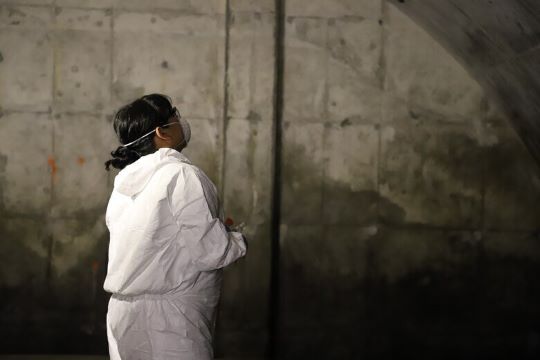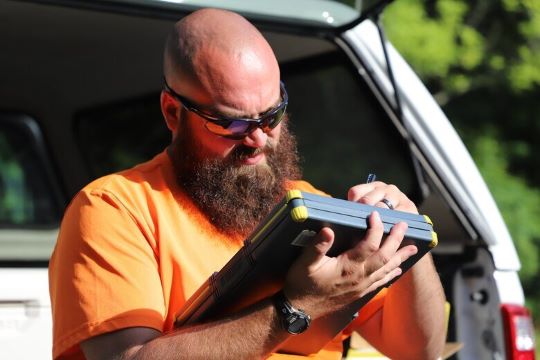In Crane, Indiana, USA, researchers from the U.S. Army Engineer Research and Development Center (ERDC) are assisting in what they view as a critical battle against time and nature.
Within the vast expanses of Crane Army Ammunition Activity (CAAA) are thousands of Earth Covered Magazines. Known as ECMs, these are crucial semi-buried bunkers that safeguard the nation’s munitions and explosives.
Vital to the Department of Defense, these facilities face constant threats of mold and corrosion, with the mold potentially penetrating packaging and affecting the munitions and rounds.
If a soldier attempts to use one of these corroded rounds, they are at risk of misfires, malfunctions, or jams, ERDC explains. Because of this, if munition shipments arrive molded, they must be discarded. This would leave a Warfighter in need of critical resources.
“This is a whole different way to look at supporting the Warfighter,” says Drew Miller, an engineering technician with the ERDC’s Construction Engineering Research Laboratory (CERL). “If we don't get ahead of this, it could affect the Warfighter. It could affect the mission.”
‘Snowball Effect’ of Corrosion
With the threat of mold and corrosion creeping in, researchers from ERDC-CERL are now offering their expertise to provide the care and maintenance needed for these shelters.
“It’s a snowball effect, so if you don’t get ahead of it now, it's going to snowball worse and worse,” Miller says. “In the end, it affects the rounds that we can use for our soldiers, for the actual Warfighter.”
Miller, as lead technician, and the rest of the team at CERL’s Paint Technology Center of Expertise (PTCx)—alongside partners from the Joint Munitions Command (JMC) and the Forest Products Laboratory (FPL) of the U.S. Department of Agriculture (USDA)—are adopting a multifaceted approach to combat these challenges.
“We’re focusing primarily on mold but also tackling all forms of corrosion,” he says. “It’s not just about active mold growth but about preventing any potential material degradation from biofilms and traditional rust.”

Army’s Collaborative Effort
Constructed mainly from the 1940s to the 1960s, the ECMs have mainly suffered from delayed maintenance due to funding constraints. According to ERDC, this presents not only a health hazard, but also a risk to the integrity of defense materials.
When mold concerns were introduced, Rebekah Wilson, a CERL chemist and the ERDC’s lead principal investigator on the effort, offered to collaborate with the Army’s executive office for corrosion control and protection.
“During our quarterly meetings, where JMC and myself serve as leads in our respective areas, JMC highlighted the concern with mold in facilities, which has impacted readiness of munitions,” Wilson says. “Conversations developed into field efforts and eventually the USDA FPL joined into the effort. It really highlights the ability of teams from diverse missions coming together with their unique subject-matter expertise to tackle a universal problem through a holistic approach.”
To address this problem, ERDC, JMC, and the USDA’s FPL are working through a variety of methods to find and test effective, long-term solutions.
“We’re doing things like taking temperature, humidity data, taking photos, and checking sensors,” Miller says. “We’ve got sensors deployed to log those environmental conditions inside versus outside of the ECMs. We’re looking at concrete moisture levels and wood moisture levels on any of the wood packaging, and we are testing remediation methods. So, we’re actually cleaning some of the mold with different cleaning products, trying to find something that's more effective.”

Long-Term Study Goals
The CAAA mission is more than a professional obligation for Miller. As an Army veteran, he says work like this reconnects him to his duty of doing what he can to benefit the Warfighter.
“This supports the boots on the ground, and that’s been a passion of mine,” Miller says. “If I can help benefit the Warfighter or protect the Warfighter in any fashion, that’s what I want to do.”
The long-term goal for this study is to increase the readiness of munitions through mitigating mold and corrosion through new technologies, as well as providing guidance for more robust policies and procedures.
To that point, PTCx is fostering an effort with CERL’s BUILDER Sustainment Management System. This is described as a web-based software application aimed at helping civil engineers, technicians, and managers decide how to best maintain building infrastructure.
Through this effort, PTCx will evaluate how the software can work with ECM-related data to provide critical information to leadership figures tasked with making decisions.
Source: U.S. Army ERDC, www.erdc.usace.army.mil.